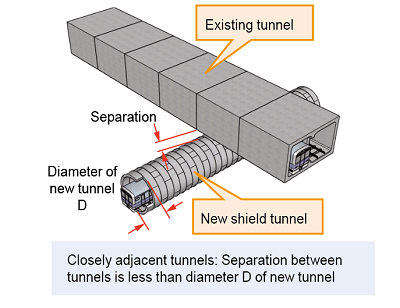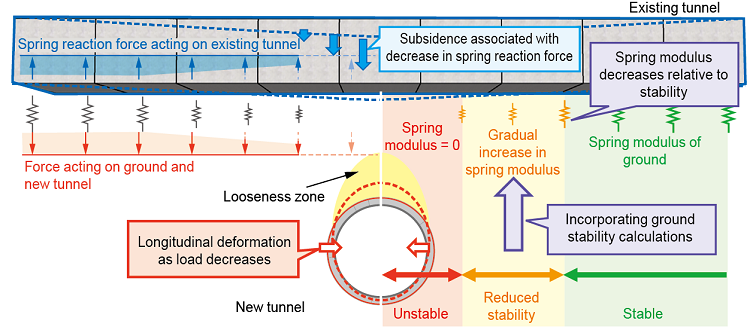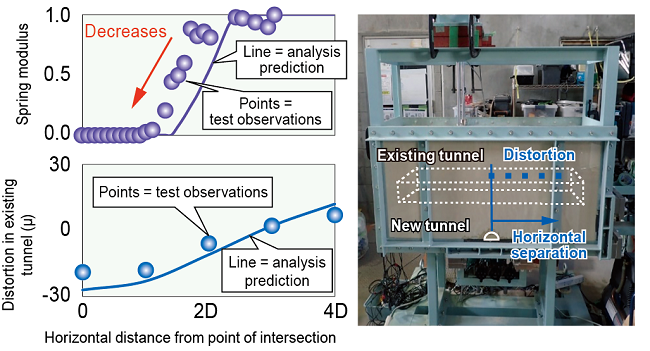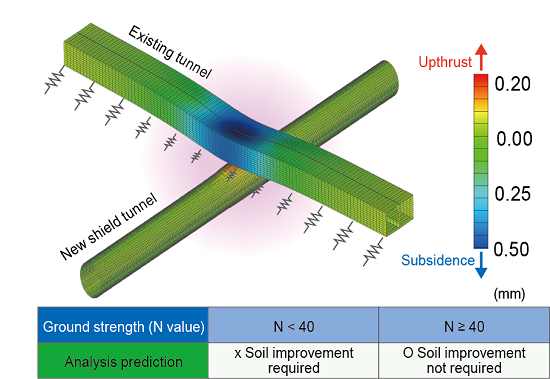16. Numerical analysis method for predicting interaction impacts on closely adjacent tunnels
Demand for new subways in major cities is making for increasingly congested underground spaces, with adjacent tunnels being built ever closer together (see Figure 1). When a new tunnel is excavated next to an existing tunnel and the separation between the two is less than the diameter of the new tunnel, excavation work can potentially impact the existing tunnel, typically by causing deformation. Technical Regulatory Standards state the special condition is required. In the absence of any formal methodology in this area, a blanket approach to soil improvement has generally been applied, regardless of the actual ground conditions, and this can add unnecessary costs. We have developed a numerical analysis method for predicting the impact of excavating a new tunnel very close to an existing one. The numerical analysis method is based on new understandings about the behavior mechanisms of closely adjacent tunnels.
The numerical analysis uses a 3-D tunnel model, and mutual interaction between the tunnel and surrounding ground is expressed using springs. We derived a calculation methodology for decreasing the spring modulus of the interaction spring as ground stability declines (see Figure 2). In trapdoor tests designed to simulate tunnels located very close together, we were able to the tendency for the spring modulus to decrease closer to the intersection point, as well as distortion characteristics in the existing tunnel (see Figure 3). Since it takes ground conditions into account, the method can be used to demonstrate that soil improvement may not be required in cases where the ground is already in suitable (see Figure 4).
Other Contents
- 9. Integrated analytics platform for railways
- 10. On-board obstacle detection system suitable for low-light conditions
- 11. Tool for estimating bridge deflection from on-board track irregularity measurements
- 12. Wear measuring apparatus for overhead conductor rail using light sectioning
- 13. Imaging analysis method for detecting various anomalies in overhead contact lines
- 14. Automated crew scheduling system
- 15. Fast-track embankment structure for confined settings
- 16. Numerical analysis method for predicting interaction impacts on closely adjacent tunnels
- 17. Method for evaluating girder vibration characteristics with consideration for track rigidity
- 18. Concrete repair methodology based on crack width and location
- 19. Using expansive concrete in track slabs to minimize reinforcement
- 20. Using temperature sensors to help predict service life of electronic signallingequipment
- 21. Effective and efficient steam weeding technique
- 9. Integrated analytics platform for railways
- 10. On-board obstacle detection system suitable for low-light conditions
- 11. Tool for estimating bridge deflection from on-board track irregularity measurements
- 12. Wear measuring apparatus for overhead conductor rail using light sectioning
- 13. Imaging analysis method for detecting various anomalies in overhead contact lines
- 14. Automated crew scheduling system
- 15. Fast-track embankment structure for confined settings
- 16. Numerical analysis method for predicting interaction impacts on closely adjacent tunnels
- 17. Method for evaluating girder vibration characteristics with consideration for track rigidity
- 18. Concrete repair methodology based on crack width and location
- 19. Using expansive concrete in track slabs to minimize reinforcement
- 20. Using temperature sensors to help predict service life of electronic signallingequipment
- 21. Effective and efficient steam weeding technique




